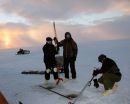(Press-News.org) RENO, Nev. - New research into the changing ecology of thousands of shallow lakes on the North Slope of Alaska suggests that in scenarios of increasing global temperatures, methane-generating microbes, found in thawing lake sediments, may ramp up production of the potent greenhouse gas - which has a global warming potential 25 times greater than carbon dioxide.
A study published this month in Geobiology - resulting from five-years of collaborative research led by Nevada's Desert Research Institute (DRI) and including scientists from NASA's Jet Propulsion Laboratory (JPL), Montana State University, and University of California, Riverside - illustrates how the decomposition of organic matter in thermokast lake sediments can produce up to three times more biological methane gas emissions when subjected to increased temperatures in a simulated environment.
Further, researchers found that the methane detected in in lake sediments in this region can arise from both ancient theremogenic sources deep in the earth, or from shallow contemporary biological sources. Interestingly, the coastal plain in the North Slope of Alaska is estimated to contain 53-billion cubic feet of natural gas trapped under the permafrost ice cap.
Thermokarst lakes occur as permafrost thaws and creates surface depressions where meltwater accumulates , converting what was previously frozen land into small freshwater lakes with active decomposing sediment layers.
While scientists have long understood that methane and carbon dioxide releases from thawing permafrost are important sources of global greenhouse gas emissions, little is known about the sources and rates of methane production (known as methanogensis) from microbial communities found in these changing environments.
"The large amount of organic matter stored in the thaw layer between the water column and the permafrost table serves as a significant source of carbon for methanogensis," explained Paula Matheus Carnevali, a doctoral student at DRI and the study's lead author. "Identifying and understanding the production sources of methane will improve our ability to generate accurate predictions about the changing climate in the Arctic."
The study focused on methane dynamics within 16 sediment cores collected over a period of four years from two Alaskan thermokarst lakes, near Barrow, Alaska. Samples were obtained from three sites, one proximal to an active, submerged natural gas seep and another from a site approximately one-kilometer away from the seep site. The second lake was located about 13-km to the northwest, and did not have visibly active seeps.
Simulated climate scenarios were performed in a controlled DRI laboratory in Reno, Nevada and scientists analyzed the potential for increased biological production of methane from methanogens found in the lake sediments; the role of the sediment geochemistry in this process; and the temperature dependency of this process.
"This study marks an important step in recognizing that there are different methane sources in close proximity that may respond differently in the changing Alaskan arctic ecosystems," said Alison Murray, Ph.D., a principal investigator on the study and expert in microbial ecology and archaea found in some of Earth's most extreme environments.
"In scenarios of warming climate," Murray said, "our measurements indicate that biological methane production may play a larger role in total methane emissions in the future, which could have a significant impact on our climate."
INFORMATION:
Funding for this research was provided by NASA's Astrobiology Institute, Astrobiology of Icy Worlds program at JPL and NASA's Astrobiology Science and Technology for Exploring Planets award.
Full text of the study available online at - http://onlinelibrary.wiley.com/doi/10.1111/gbi.12124/abstract
Additional photos available upon request.
About the Desert Research Institute: DRI, the nonprofit research campus of the Nevada System of Higher Education, strives to be the world leader in environmental sciences through the application of knowledge and technologies to improve people's lives throughout Nevada and the world.
March 30, 2015 - There are few global public health issues of greater importance than antimicrobial resistance in terms of impact on society. Many existing antimicrobials are becoming less effective and the development pipeline for new antibiotics is at an all-time low. Thus, change is needed to address antimicrobial resistance. This complex global public health challenge is tackled in a timely special focus issue of Future Microbiology, a peer-reviewed journal published by Future Medicine Ltd.
Modern medicine relies on the widespread availability of effective antimicrobials ...
New research from the University of Copenhagen has found that the beneficial effects of exercise are more important for our health than the negative effects of air pollution, in relation to the risk of premature mortality. In other words, benefits of exercise outweigh the harmful effects of air pollution.
The study shows that despite the adverse effects of air pollution on health, air pollution should be not perceived as a barrier to exercise in urban areas. "Even for those living in the most polluted areas of Copenhagen, it is healthier to go for a run, a walk or to ...
PULLMAN, Wash. -- Washington State University researchers have found that an unexpectedly high percentage of young people experience "exploding head syndrome," a psychological phenomenon in which they are awakened by abrupt loud noises, even the sensation of an explosion in their head.
Brian Sharpless, a Washington State University assistant professor and director of the university psychology clinic, found that nearly one in five -- 18 percent -- of college students interviewed said they had experienced it at least once. It was so bad for some that it significantly impacted ...
1. USPSTF reviews evidence to update recommendations on iron supplementation and deficiency screening in pregnant women
The U.S. Preventive Services Task Force (USPSTF) reviewed published evidence to update its recommendations on iron supplementation and screening for iron deficiency anemia in pregnant women. The evidence review is being published in Annals of Internal Medicine simultaneously with an evidence review in Pediatrics on screening for iron deficiency anemia in young children.
Iron needs increase during pregnancy due to the demands of the growing fetus and ...
Distasteful though it sounds, the transplantation of fecal matter is more successful for treating Clostridium difficile infections than previously thought.
The research, published in the open access journal Microbiome, reveals that healthy changes to a patient's microbiome are sustained for up to 21 weeks after transplant, and has implications for the regulation of the treatment.
Clostridium difficile infections are a growing problem, leading to recurrent cases of diarrhea and severe abdominal pain, with thousands of fatalities worldwide every year. The infection is ...
Recreational users of coastal waters such as swimmers and surfers are at risk of exposure to antibiotic resistant bacteria, according to new research published this week.
In the first study of its kind, scientists at the University of Exeter Medical School have assessed the amount of water ingested during different water sports and combined this with water sampling data to estimate people's exposure to bacteria resistant to antibiotics.
Using data gathered across England and Wales in 2012, they estimated that over 6.3 million water sport sessions resulted in one type ...
Parents of obese children may not be able to recognise that their child is overweight unless they are at very extreme levels of obesity, according to research led by London School of Hygiene & Tropical Medicine and UCL Institute of Child Health, research partner of Great Ormond Street Hospital.
The work, which is published in the British Journal of General Practice, finds that parents are additionally more likely to underestimate their child's weight if they are Black or south Asian (v white), from more deprived backgrounds or if their offspring is male. The identification ...
March 29, 2015 - San Francisco - Even rats can imagine: A new study finds that rats have the ability to link cause and effect such that they can expect, or imagine, something happening even if it isn't. The findings are important to understanding human reasoning, especially in older adults, as aging degrades the ability to maintain information about unobserved events.
"What sets humans apart from the rest of the animal kingdom is our prodigious ability to reason. But what about human reasoning is truly a human-unique feature and what aspects are shared with our nonhuman ...
BOSTON, MA (March 29, 2015) - According to new analysis of data from the 2009-2012 National Health and Nutrition Examination Survey (NHANES) that evaluated eating patterns of 3,647 children ages 4-13 years, skipping lunch is a common practice among children and adolescents, with 13% of younger children and 17% of 9-13 year olds skipping lunch on a given day. The study found that the behavior persisted throughout the week with nearly a quarter (approximately 23%) of 9-13 year olds skipping lunch on the weekends. These findings, part of Nestlé's new Kids Nutrition & ...
A new study presented today at the World Congress on Osteoporosis, Osteoarthritis and Musculoskeletal Diseases reveals the high cost of first and subsequent hip fractures to the healthcare system in the UK.
Researchers from the University of Oxford and the MRC Lifecourse Epidemiology Unit in Southampton estimated UK hospital costs of hip fracture in the two years following the fracture, and compared average hospital costs before and after hip fracture. Their study analyzed data from 33152 hip fracture patients (average age 83 years), 75% of which were women.
The study ...


